Lake Louise (originally known as Horâ Juthin Îmne, or Lake of Little Fishes) is just one of many incredibly beautiful mountain lakes in the Alberta Rockies, but it is by far the most popular. Receiving up to 15,000 visitors a day in the summer months, crowds can get pretty insane, turning it into the “Disneyland of the Rockies”. Hiking at Lake Louise is considered a bucket list item for many, and many visitors to Banff plan spending time on the Lake Louise hiking trails as a highlight of their trip.
The hiking trails in lake Louise lead to a variety of incredible views looking down towards the lake and out over the surrounding mountains. With a range of difficulty from “anyone can do this” to “scrambling experience required”, there really is something for almost anyone. I’ve listed all of the best Lake Louise hiking trails, going from the shortest and easiest and getting increasingly challenging from there.
Continue reading this blog post for everything you need to know to experience these amazing Lake Louise hiking trails for yourself, including distance, elevation gain, how to get there, the best time to visit, and lots of photos of my experience.

Tips for Hiking Lake Louise
Hiking trails in Lake Louise, including at the teahouses, have no garbage bins. I’ve seen dozens of tourists carrying Starbucks cups up the Lake Agnes hike, and I can’t believe that they all carried their empty cups back down. Make sure that any waste that you carry up, or anything that you buy from the teahouse, you are prepared to carry down yourself. Conveniently, the teahouses do have a couple of outhouses that, despite extensive signage, selfish idiots frequently use as garbages – throwing plastic bottles and wrappers down. Obviously these things don’t biodegrade, meaning that the teahouse workers are forced to fish out whatever garbage you throw down there. Have some human decency and don’t do this.
Before visiting Banff National Park it’s essential to read up on the Parks Canada rules that must be followed to avoid tickets and/or fines. When hiking it’s important to avoid harmful practices such as disturbing plants or rock-stacking, or removing any natural object from flowers to rocks, as it’s important to leave the environment as natural as possible for the animals and for fellow hikers to enjoy in perpetuity. As many flowers as there are, there are few enough that if we all took one, then there wouldn’t be any left. If you’re after a souvenir to take home with you, there are tons of gift shops in the Banff townsite to check out. Otherwise take only photos, leave only footprints.
If you haven’t heard of Leave No Trace principles, they’re also really essential to read up on before heading anywhere into the outdoors in general. Following these important principles basically means doing your best to leave beautiful places like Lake Louise as good (if not better) than you found them, both for their preservation and for the enjoyment of other visitors.
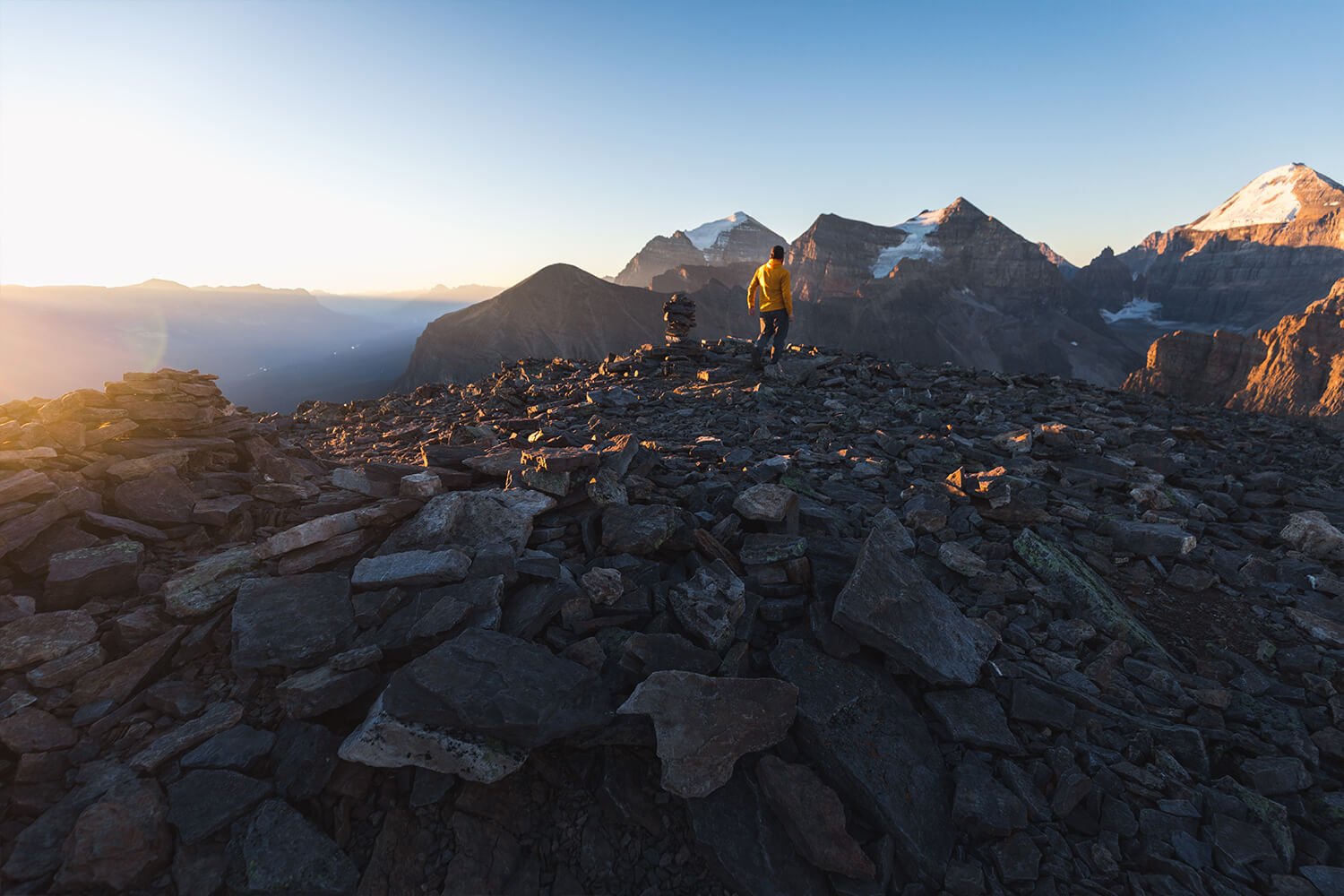
How to Get to Lake Louise
Lake Louise is located in Banff National Park, meaning that a valid park pass is required. Day passes can be purchased at the park gates and are per day per person, but if you’re staying a week or longer, it’s more cost-effective to just buy an annual pass instead.
It’s easy to reach Lake Louise from the town of Banff, as it’s only 45 minutes north along the incredibly scenic TransCanada Highway, however it does require some planning on preparation. It’s possible to drive to Lake Louise yourself by car or if you’d prefer to just relax and admire the mountain views, there are regular shuttles between Lake Louise and the Banff townsite.
Planning on visiting Lake Louise by car? You might want to think again. The Lake Louise parking lot fills up as early as sunrise during peak tourist season, and it can be incredibly difficult to find parking at the lake throughout the rest of the day. If the parking is full when you arrive, there is no choice but to turn the car around. This is why it’s highly recommended to park at the Lake Louise ski resort and take a shuttle bus to the lake, as this is the only way to guarantee making it to Lake Louise in the summer. Seriously, I have seen so many disappointed tourists leave without seeing Lake Louise because they didn’t plan ahead. Reservations must be made ahead of time (that’s right – you can’t just show up and expect to get to lake Louise!) and can be made on the Parks Canada website.
Best Lake Louise Hiking Trails
Fairview Lookout

Distance: 2 km / 1.2 mi
Elevation Gain: 180 m / 590 ft
Hiking Time: 40 mins
The Fairview Lookout over Lake Louise in Banff National Park is a short and sweet hike ending with a gorgeous view over the entire Lake Louise area. When I did the twenty-minute walk up there for sunrise I was shocked to have it all to myself – there was easily over a hundred people getting their sunrise photo from the lakeshore in front of the Fairmont Chateau Lake Louise. (You can see the crowd at right in the picture below.) The walk to the Fairview Lookout is definitely the easiest of the Lake Louise hikes, making it a perfect hike for families or beginner hikers. If you’re in the area it makes for a beautiful sunrise, but I’m sure it would be equally stunning any time of day.
The Fairview Lookout hike starts straight from the Lake Louise parking lot. From here it leads clockwise around Lake Louise, gently gaining elevation until reaching the viewpoint. The path is wide and relatively gentle the entire way.

Lake Agnes
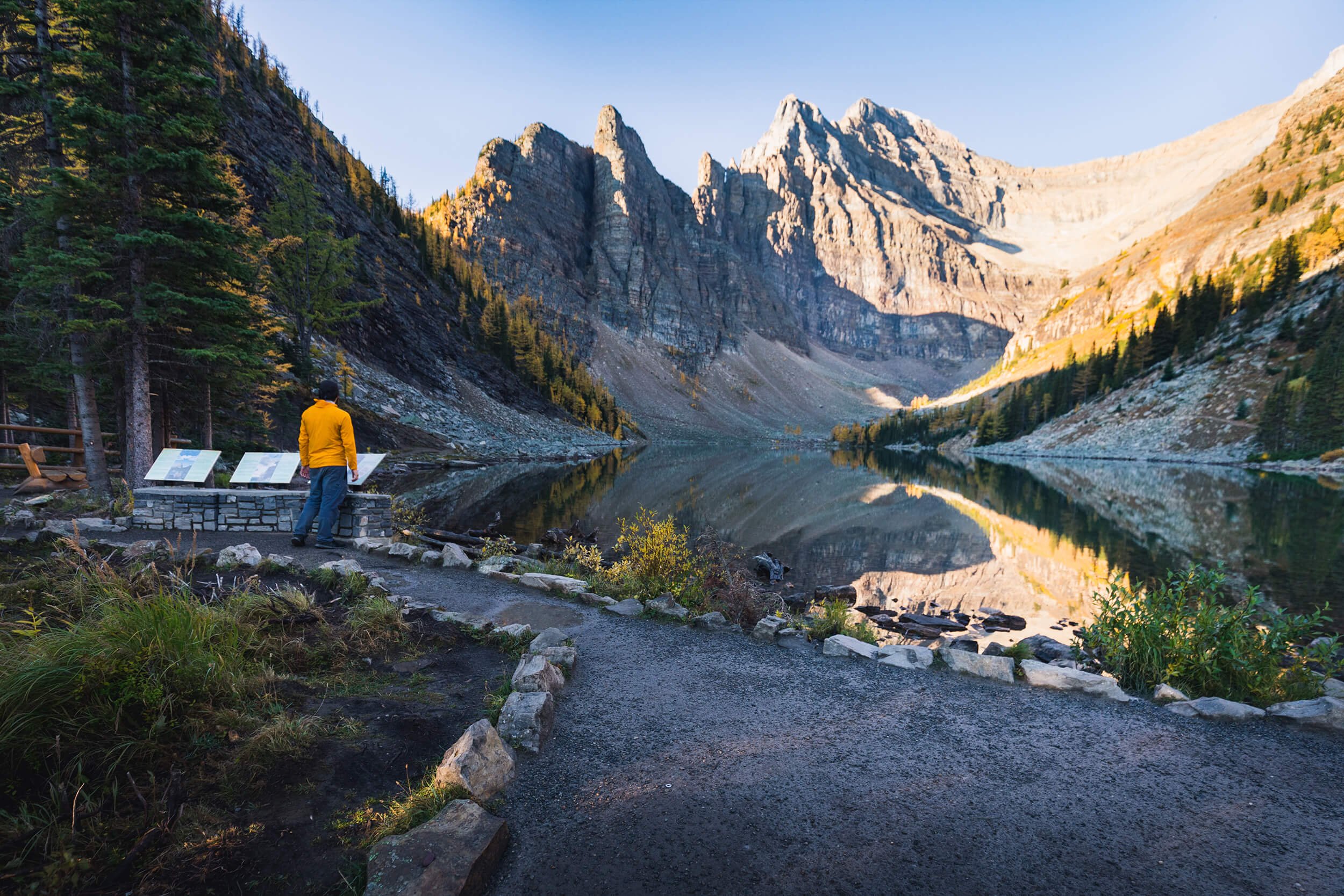
Distance: 7.1 km / 4.4 mi
Elevation Gain: 495 m / 1624 ft
Hiking Time: 1-2 hrs
The Lake Agnes Teahouse has sat on the edge of Lake Agnes for over 120 years. Though the original cabin was replaced with a newer structure in 1981, much of the original furnishings were salvaged and can be seen incorporated into the current teahouse. The iconic Canadian institution serves over 100 kinds of tea with water from Lake Agnes and also has some simple food. Wondering how the tea and food gets up there? The teahouse workers can be seen carrying supplies on their back up the trail 2-4 times a week! The Lake Agnes Teahouse is open June 4 to October 10 from 8:00 am to 5:00 pm. Most mornings there is a long line outside the teahouse well before it opens for the day.
The hike from Lake Louise up to Lake Agnes and the Lake Agnes Teahouse is beautiful, not too challenging, and more than anything else incredibly popular. In fact, I think it’s pretty safe to call it the busiest trail in all of Banff National Park. While most vistors only make it as far as the Lake Agnes Teahouse before turning back, I highly suggest extending your hike a few kms further via one of several different trails offering incredible viewpoints, and much quieter and peaceful experiences.
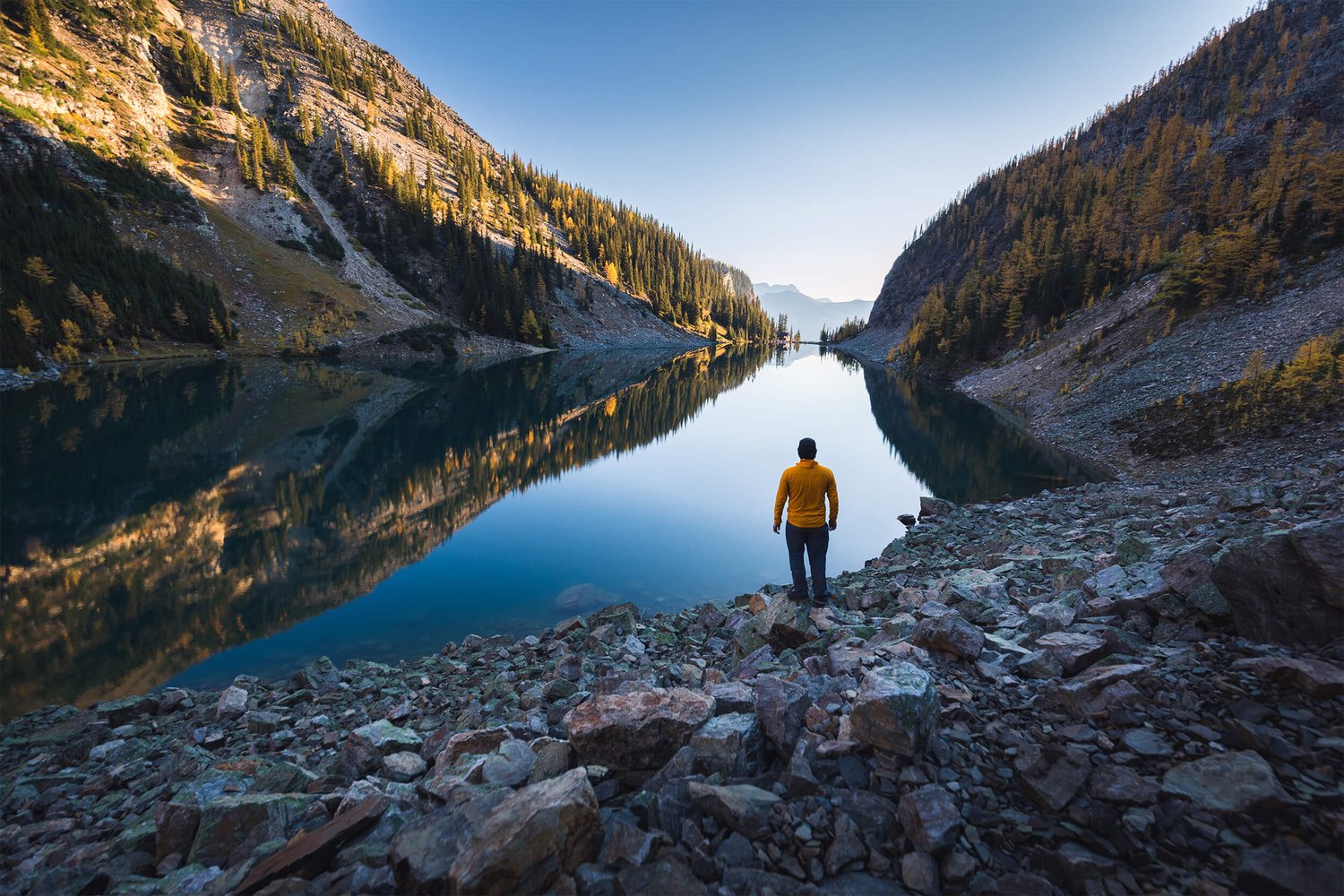
Plain of Six Glaciers
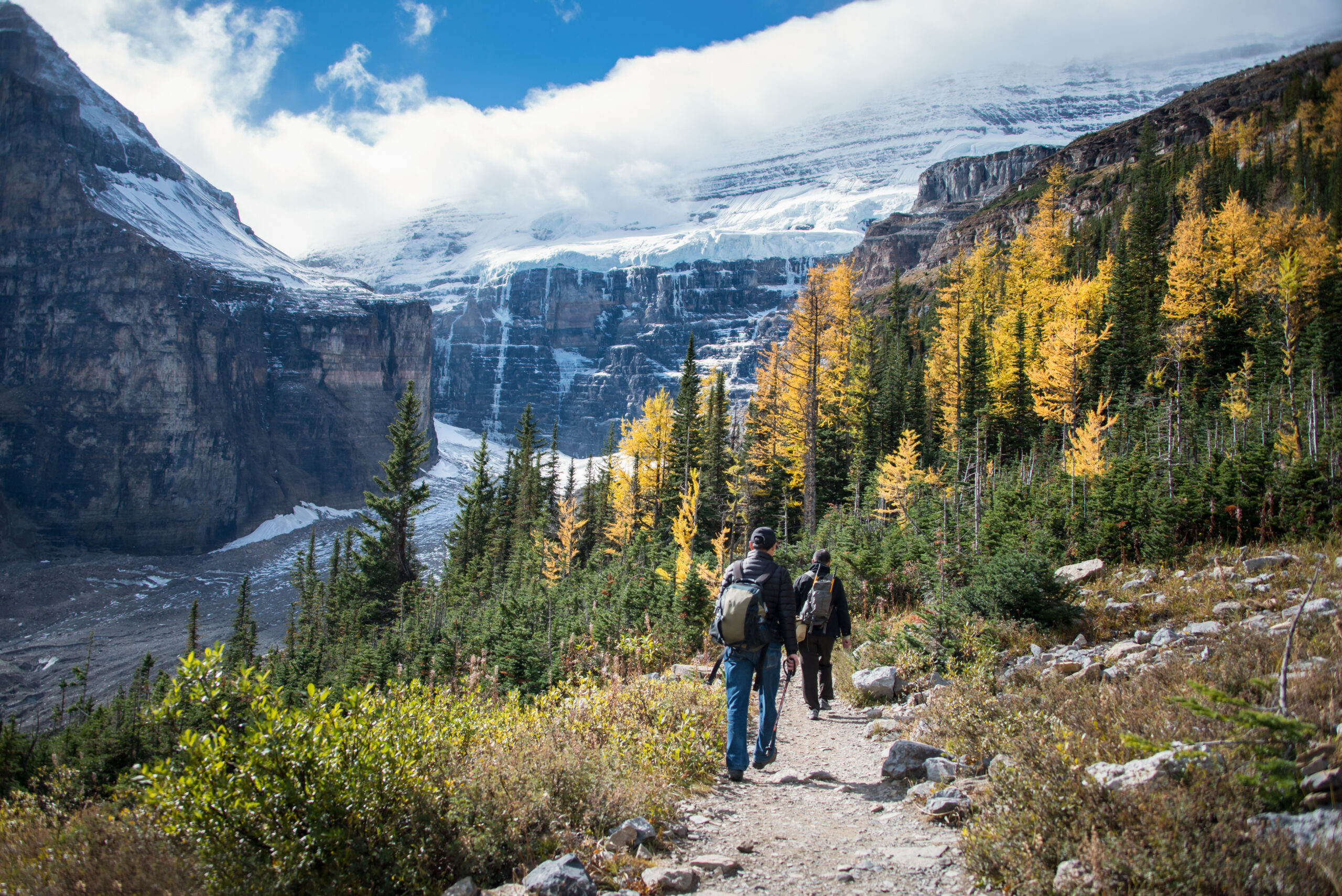
Distance: 13.2 km / 8.2 mi
Elevation Gain: 534 m / 1752 ft
Hiking Time: 4 hrs
Looking for a unique perspective on Lake Louise? The Plain of Six Glaciers Trail leads past the iconic lake up into the glacial valley on the other side. The trail passes through wildflower-filled meadows before switchbacking up to the barren and bleak rocky landscape left behind by the retreating glaciers. Here, the Plain of Six Glaciers has operated since 1927, serving hikers with light lunches and beverages.
Little Beehive

Distance: 11 km / 6.8 mi
Elevation Gain: 613 m / 2011 ft
Hiking Time: 3 hrs
The trail up to Little Beehive starts off fairly busy as it winds its way up from Chateau Lake Louise. Fortunately the vast majority of hikers turn back after reaching the iconic Lake Agnes Teahouse, leaving the rest of the trail up to the peak of Little Beehive relatively quiet (by Banff standards.) The trail is relatively easy if a bit steep for some, and requires nothing technical. While some intimidating peaks in the region require advanced scrambling skills or ropes, this Lake Louise hike offers fantastic views without being anything more than a hike. In my opinion, it has the best views to effort ratio of any Lake Louise hike, and is a better alternative to the more popular (and in my opinion, slightly less scenic) Big Beehive hike.
Hikers heading up to Little Beehive will enjoy beautiful views along the way of Mirror Lake, Lake Agnes, and if hiking in late September as I did, a beautiful sea of golden larch trees.

Big Beehive
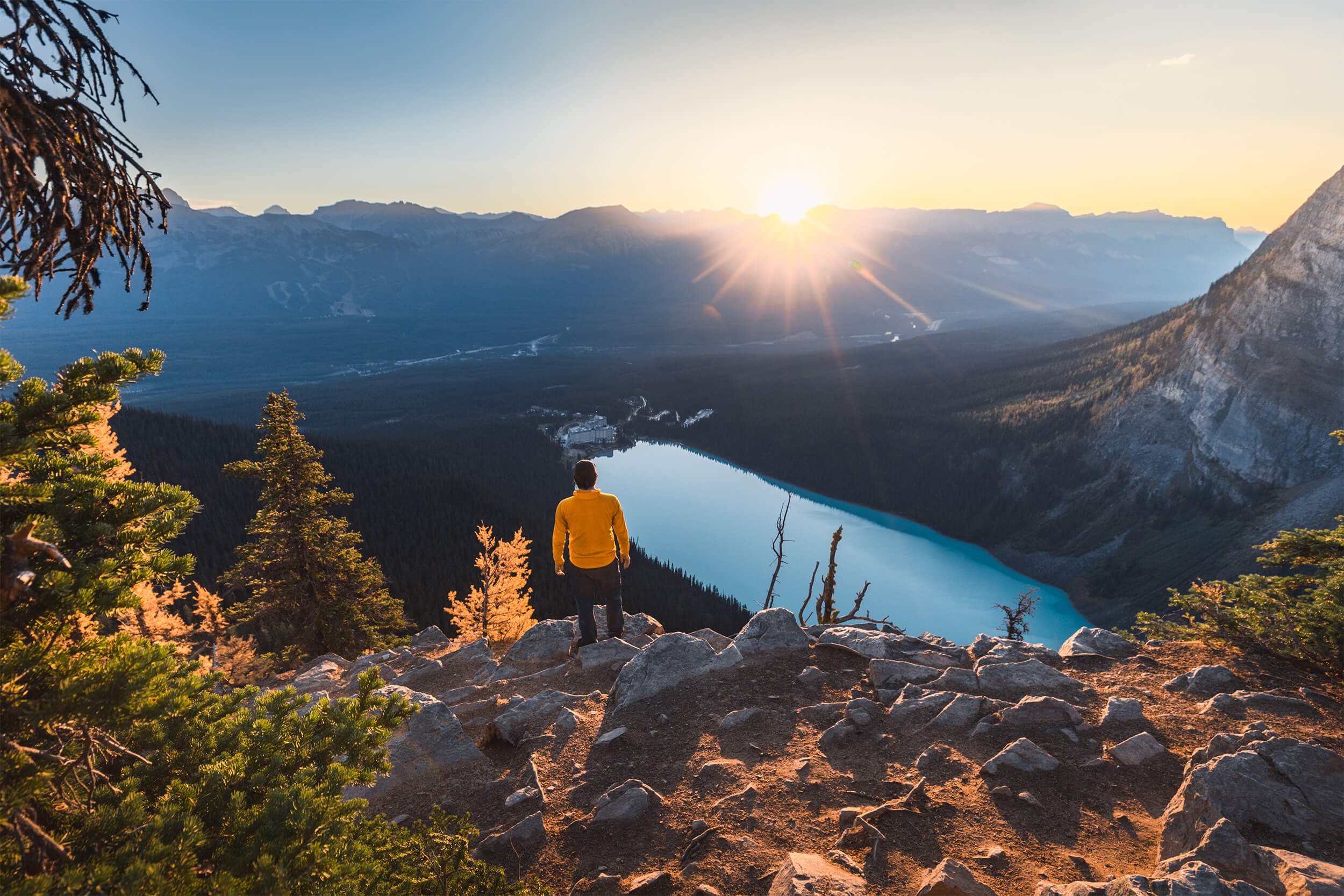
Distance: 10.4 km / 6.5 mi
Elevation Gain: 750 m / 2460 ft
Hiking Time: 3 hrs
Originally named just The Beehive by original Chateau Lake Louise manager J. Willoughby Astley in 1890, Lake Louise’s iconic and popular lookout point is now more commonly known as Big Beehive, to avoid confusion with another gorgeous nearby lookout known as Little Beehive. It has remained for decades an incredibly popular hike in the area among visitors wanting gorgeous views straight down over the turquoise waters of world-famous Lake Louise.
For much of the hike the destination of Big Beehive is visible, at first looking very intimidating from the front. Fortunately the trail winds up around the side before switchbacking up to the top to reveal stunning views from almost directly above Lake Louise. The Big Beehive hike is one of the most popular hikes in Banff National Park for a reason, and is a must-do when visiting the Lake Louise area.
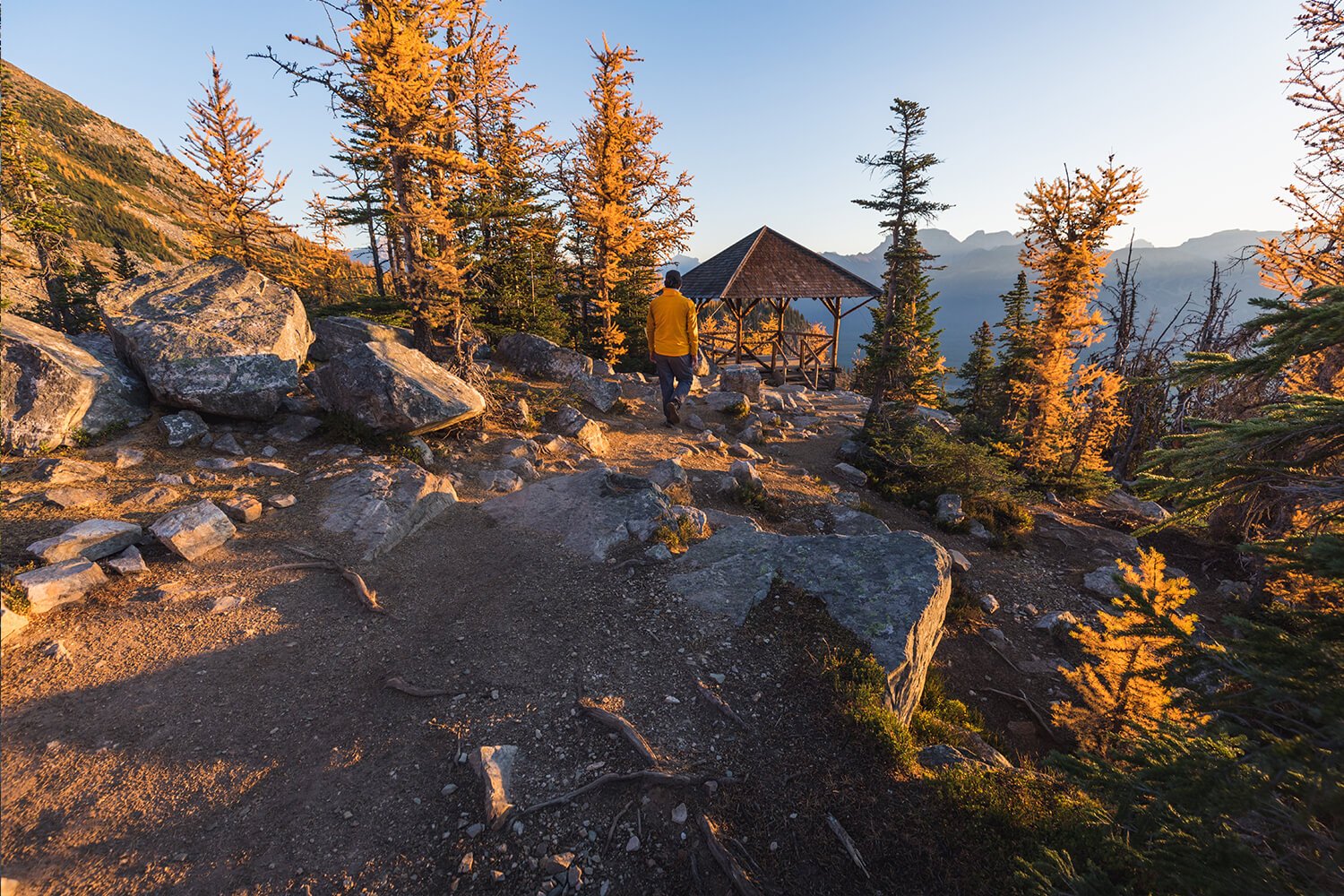

Devil’s Thumb
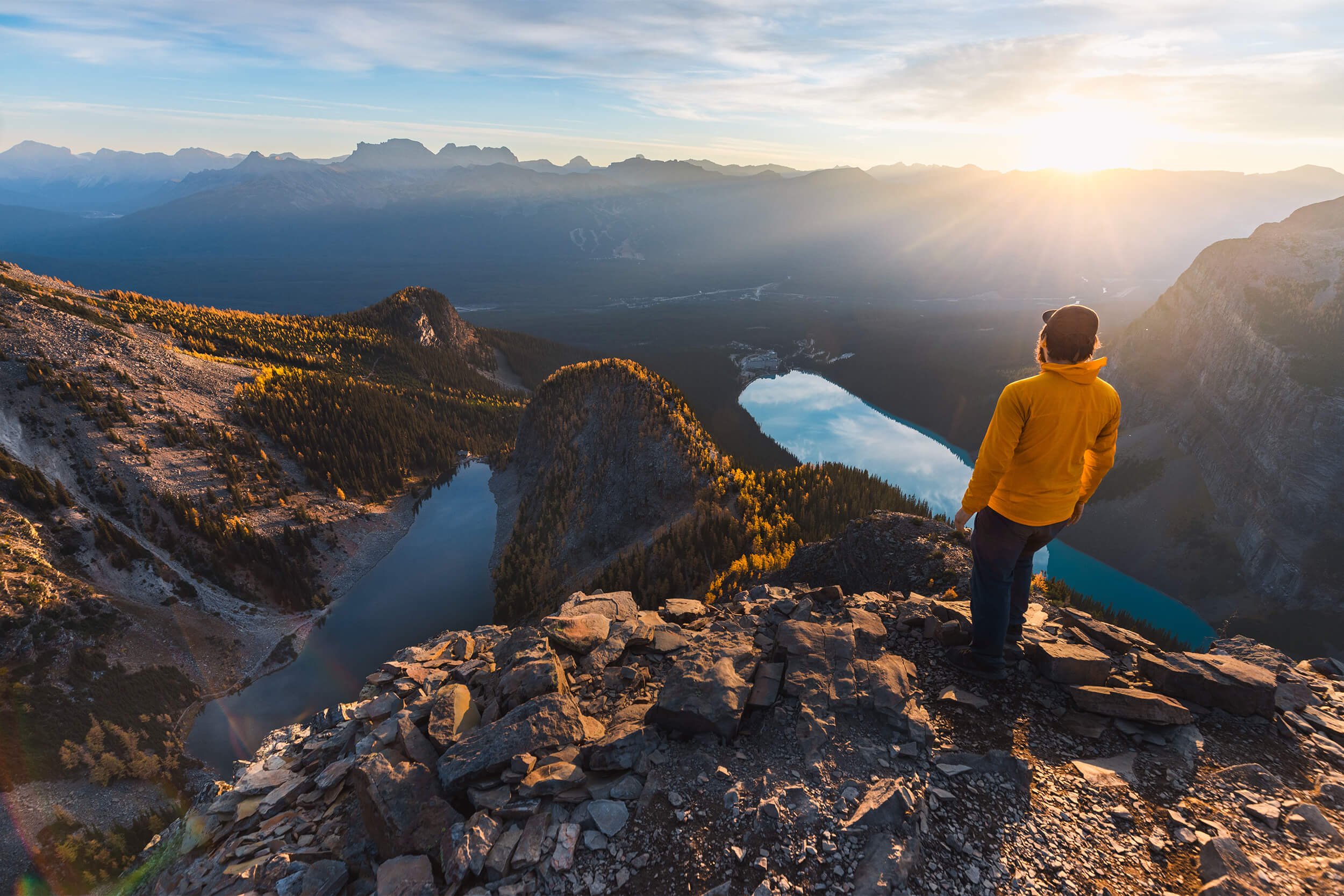
Distance: 14.2 km / 8.8 mi
Elevation Gain: 834 m / 2736 ft
Hiking Time: 4-5 hrs
Devil’s Thumb, first ascended by Lake Louise pioneering mountaineer S. E. S. Allen in 1892, is today a popular and challenging peak that is regularly climbed by both locals and visitors to Banff’s Lake Louise. If you’ve been up to Lake Agnes you’ve seen it for yourself. From that angle it looks like a near-vertical column of rock protruding out at the other end of the lake.
Fortunately it’s not quite as difficult to ascend as it looks, but the route up Devil’s Thumb is steep and not for the unprepared or the inexperienced. Despite what its frequent usage might suggest, it is not an official trail and is not maintained by Parks Canada. Expect super steep gravelly slopes and some scrambling.
At the top of Devil’s Thumb are some of the most iconic and most magnificent views in the Lake Louise area that one can get, and the feeling of accomplishment for having made it to the top can’t be understated. Views from Devil’s Thumb extend over both Lake Agnes and Lake Louise, and offer stunning panoramic views of the mountains and glaciers in every direction.

Mt St Piran

Distance: 14.2 km / 8.8 mi
Elevation Gain: 955 m / 3133 ft
Hiking Time: 5-6 hrs
Mt St Piran is one of the more challenging hikes in the Lake Louise region, though it never is particularly technical. An occasionally faint trail leading away from the Little Beehive hike requires a bit of routefinding experience and the final steep section up the rocky slope might be too intimidating for experienced hikers. The unofficial trail is not maintained by Parks Canada, and as a result the hike isn’t going to be recommended by Parks employees, but there is never any real exposure. The trail is occasionally classed as a mild scramble, but as long as one stays on the trail it can be nothing more than a steep hike. Those experienced in 1000m+ Rocky Mountain ascents will likely have no difficulty with this beautiful trail but newer hikers will probably prefer the shorter hike to Little Beehive. It offers my absolute favourite view in the Lake Louise area from near the summit, from where it’s possible to see Lake Louise, Mirror Lake, and Lake Agnes all at once.
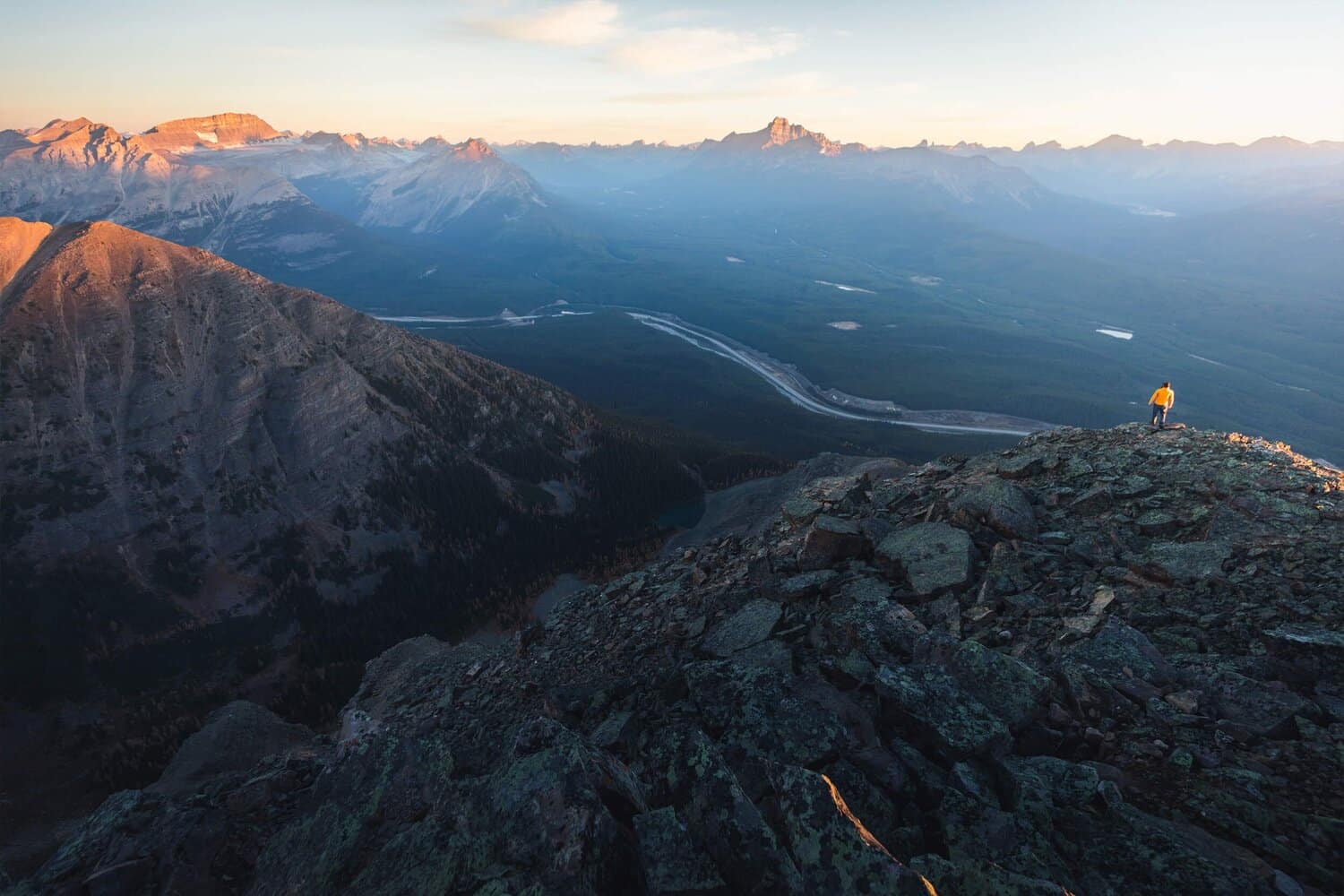
Saddle Mountain
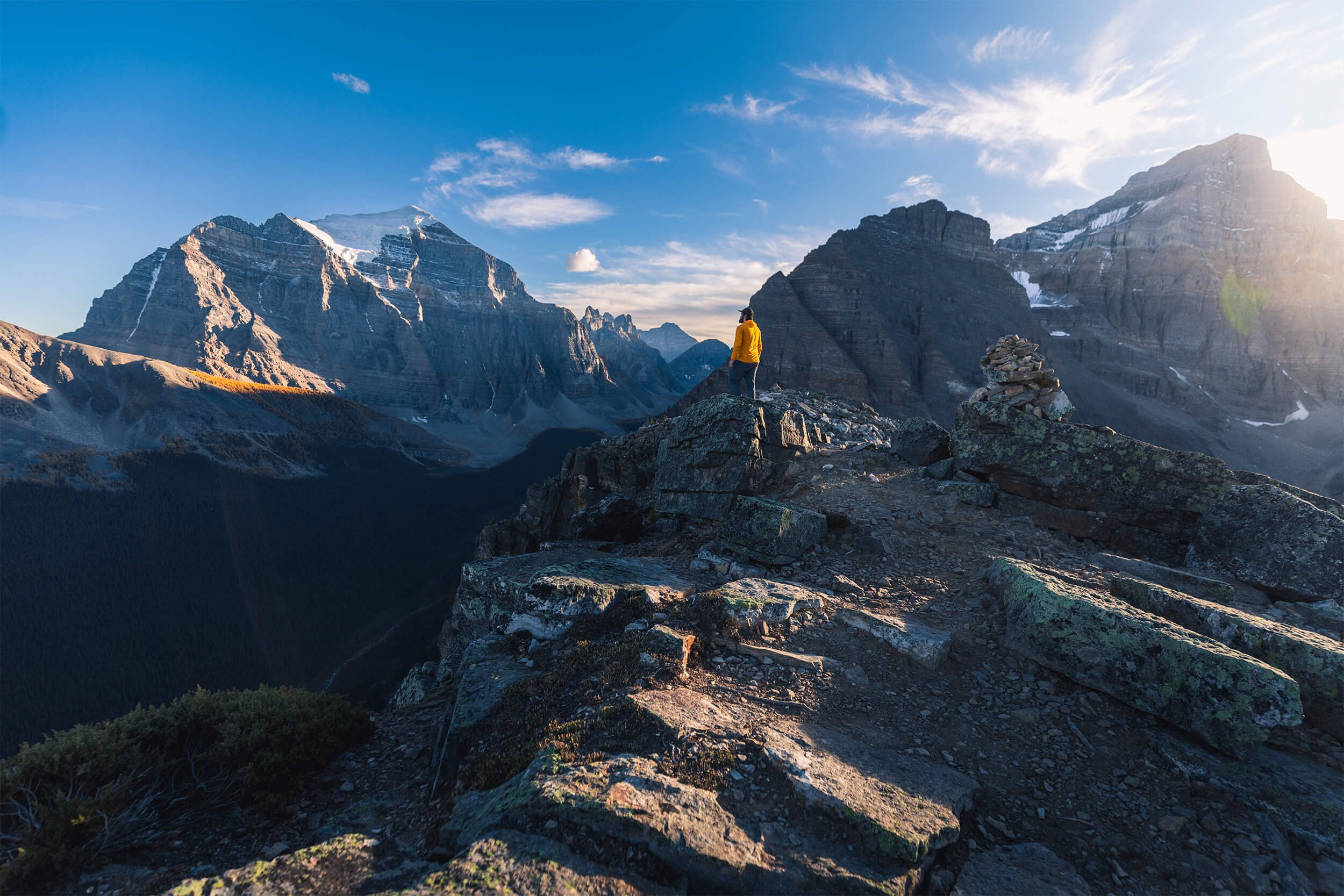
Distance: 9 km / 5.6 mi
Elevation Gain: 656 m / 2152 ft
Hiking Time: 4 hrs
Saddle Mountain is a fantastic Banff hike, and one of my favourite hikes near Lake Louise. Offering jaw-dropping views of Mt Temple and into the Paradise Valley, as well as a stunning panorama of mountains stretching up and down the Bow Valley, it’s surprising how little work is required to bag this peak.
The trail starts from the Lake Louise lakeshore and steeply heads up to Saddleback Pass between Saddle Mountain and Fairview Mountain. The top of the pass is for many people a destination in itself thanks to the brilliant larch forest there. It’s at the top of the pass that the official trail ends, but a social trail leads up some fun scrambling up the bouldery side of Saddle Mountain. From Saddleback Pass the summit of Saddle Mountain seemed high up out of reach still, but I was so distracted by the incredible views and the fun easy routefinding that it felt like I was at the summit in a matter of minutes.
I highly recommend Saddle Mountain for those looking for a little more adventure than your standard on-trail hike, without being too arduous as far as distance or elevation gain.
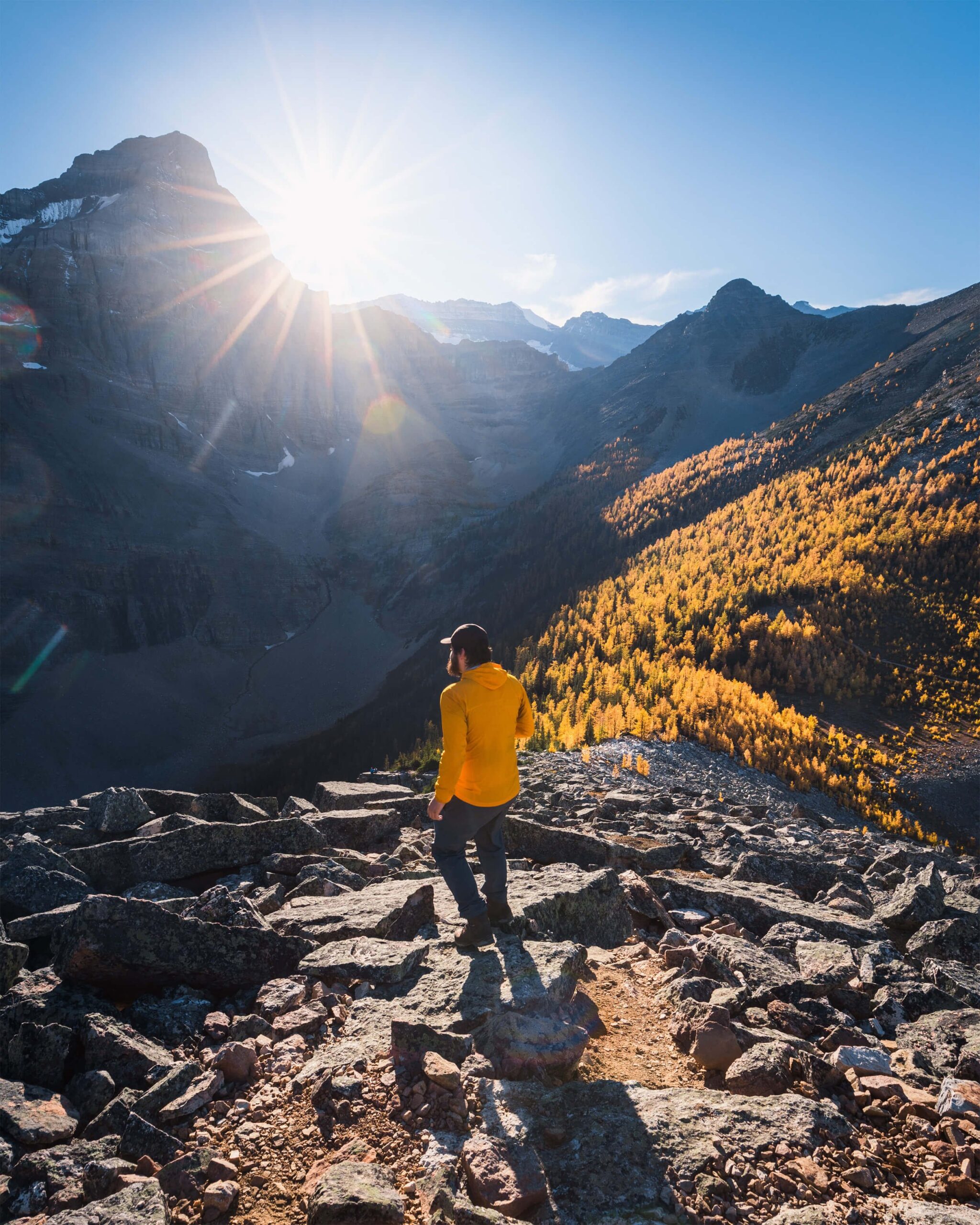
Fairview Mountain
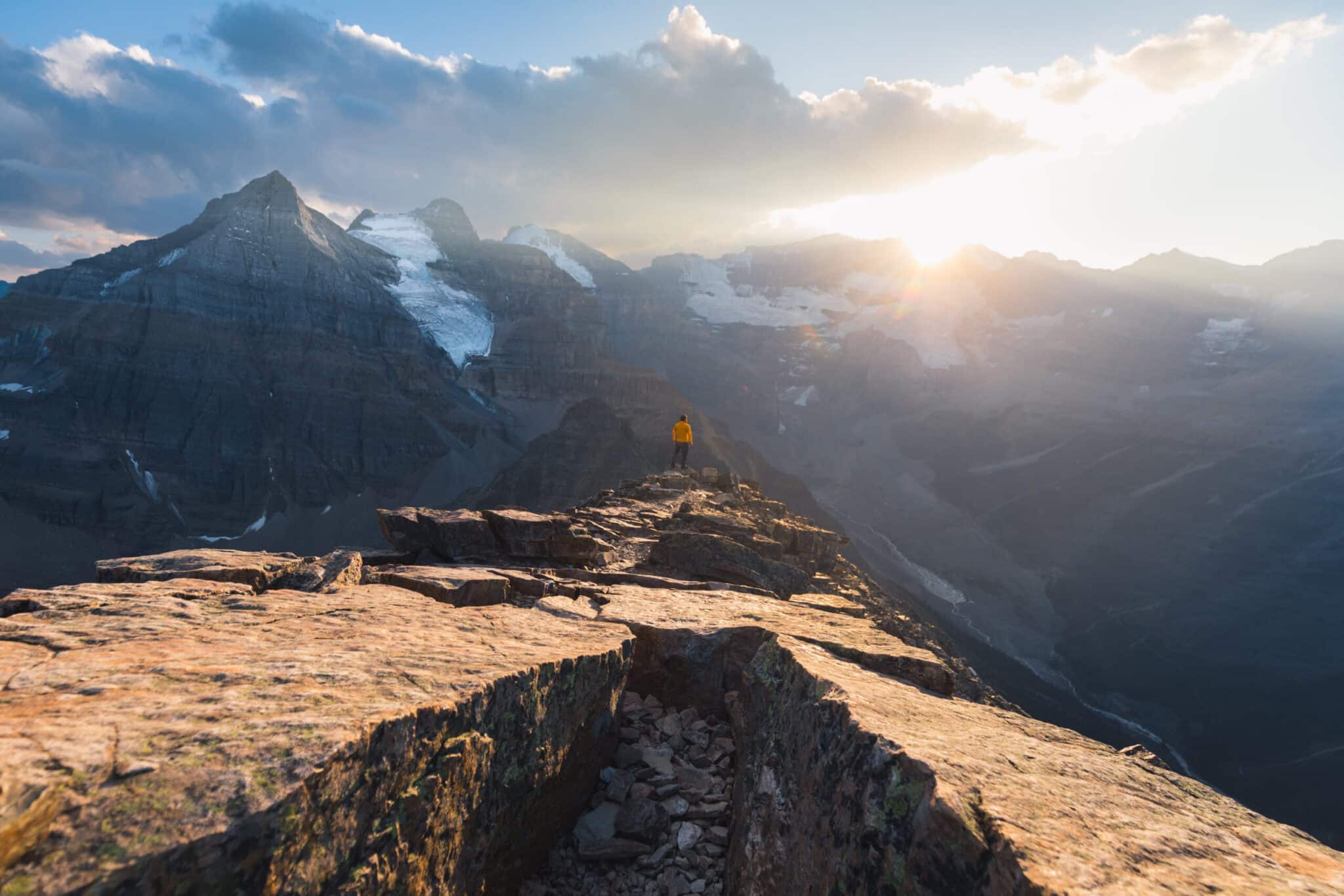
Distance: 10.7 km / 6.6 mi
Elevation Gain: 1016 m / 3333 ft
Hiking Time: 4-5 hrs
With an elevation of 2,744 m, the summit of Fairview Mountain is one of the highest points that can be hiked near Lake Louise, and is one of the easiest and most accessible “real” mountains in all of Banff. While there are plenty of higher peaks in the area, they all require scrambling or even more technical skills. Fairview Mountain is a bit long, and a bit steep at times, but is never anything more than a challenging hike. It’s surprising that a gorgeous mountain summit as accessible as Fairview Mountain doesn’t see more visitors. Unlike Mt St Piran on the other side of Lake Louise, Fairview Mountain ddoesn’t rally offer many views of the lake itself, but the views up and down the Bow Valley and into Paradise Valley as well as of the surrounding peaks and glaciers and jaw-dropping.
If you’re an experienced hiker looking to push past the crowds and enjoy some of the most incredible yet still accessible views in the area, Fairview Mountain is the hike for you.
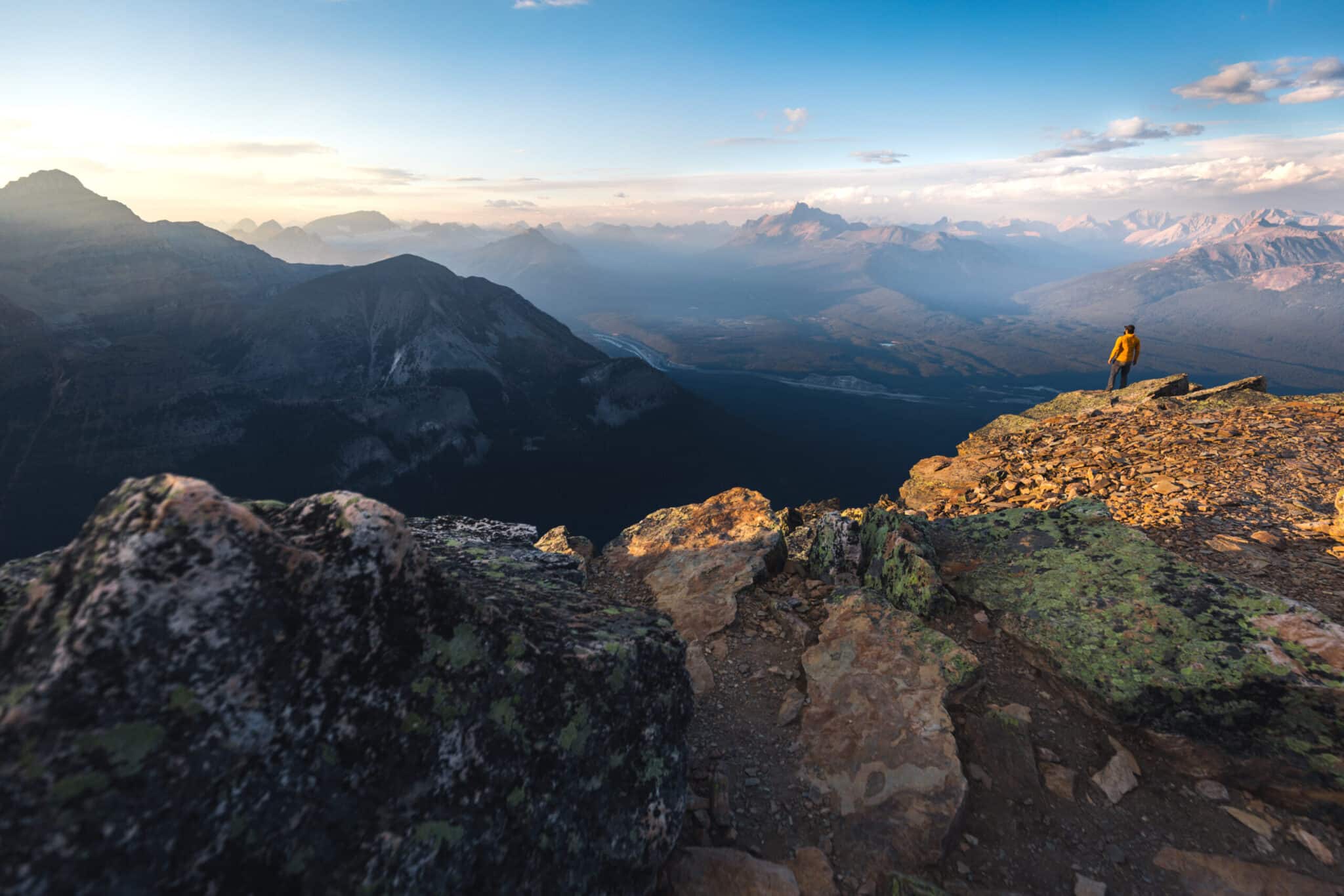
Recommended Hiking Gear



Water is a must whenever I’m hiking, especially if the sun is going to be out. My favourite water filter I’ve used is the Katadyn BeFree 0.6L, which unlike other water filters I’ve used packs up really small and lightweight. For hikes where I know there won’t be any readily available water sources along the way, I make sure to bring my own. The Hydrapak Stow 1L bottle is my go-to, for the same reason that it’s made of a soft plastic that folds up and doesn’t take up any more extra space than necessary in my pack. Finally, Aquatabs are another great option for purifying water, with one tablet being suitable for one litre of water. I previously used the Grayl water filter while travelling internationally, and though I found its hard body more convenient for day to day use and easier to drink from, it has a little too much bulk for my fast-and-light style of hiking.



The secret to all my photos of gorgeous sunset and sunrise mountaintop views? A lot of hiking in the dark. And let me speak from personal experience when I say that the last thing that you want to happen when hiking is to be caught in the dark without a headlamp. I used the Black Diamond Spot 400 for years and it worked great – until I lost it on top of a mountain somewhere. The only downside to it was having to worry about the batteries dying, though there’s also a slightly more expensive version that has a rechargeable battery. Nowadays I’m using the Petzl Actik Core, which is a bit pricier than the more budget-friendly Black Diamond, but is also brighter, more comfortable (in my opinion), and has a hybrid power system that is rechargeable but can also take AAA batteries if needed.
You won’t see me using trekking poles on shorter hikes often – but on long hikes and backpacking trips, as well as certain scrambles, they are an absolute lifesaver. I’ve invested in a high quality ultra-lightweight pair of MSR DynaLock Ascent carbon poles which, while pricey, I don’t regret one bit. If you’re not entirely sure how much use you’re going to get out of a pair of trekking poles, the best budget-friendly option would be the Trekology Trek Z 2.0. Amazon does sell a lot of cheaper Made in China-style trekking poles for cheaper, but these usually are much much heavier and not worth buying.
All the best and most long-lasting cables and power banks I’ve ever owned have been Anker. I once had a phone cable from them that lasted me over three years of daily use! That’s why I keep an Anker PowerCore Essential 20K power bank on me. Like many people I use my phone for a lot of stuff when hiking (checking in with family, using online maps, taking photos, flying my drone) so I like to be prepared for that low battery warning by having a backup power source on me just in case.



The only socks I ever buy for myself are from Darn Tough, and I almost always make sure to wear them when hiking. After years of having no problems only wearing these comfortable and rugged socks for hikes, I accidentally wore a pair of no-name socks on a hike last year and ended up with blisters on both feet. Safe to say I’m back to sticking with the Darn Tough. And the best part? They have a lifetime guarantee, meaning that if they ever wear out you can send them back for a brand new pair. For hiking footwear I go between a pair of lightweight approach shoes for quick and dirty mountain ascents or anything involving scrambling and more heavy-duty boots for longer treks. I’ve worn a couple different versions of the lightweight but super durable Arc’teryx Konseal FL 2 approach shoes for a few years now and am very impressed with the durability. I also really like the thick toecap that keeps me protected every time I stumble into a root or large rock. For longer, tougher, or muddier treks I rely on my LOWA Camino EVO GTX, which I find insanely comfortable and made of very high quality.



I wear my Ar’teryx Gamma Lightweight Pants on every single hike I go on, and on many days when I’m not hiking. After several years of abuse they are still holding together extraordinarily well, with only a few small holes from where I’ve fallen down and some slight stains from being repeatedly coated with mud. They’re lightweight, breathable, and super comfortable. For lightweight and breathable hiking tops I’m a big fan of both the Patagonia Capilene Shirt and the MEC Core Shirt. My Arc’teryx Squamish Hoody shows up in a lot of my photos. It’s super lightweight and packable, and does a great job of cutting the wind while also being pretty breathable. I also have an Arc’teryx Atom Hoody and Arc’teryx Beta LT that I pull out for cooler or wetter conditions.
